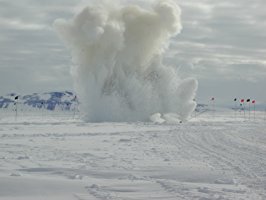
The South Pole may be nearly 10,000 miles from Silverton, Colorado, but the remote town in the San Juan mountains and the bottom of the world share something besides snow and cold. John Wright, a Silverton mining and geological engineer, oversaw the building of a snow route across Antarctica. The 1,032-mile-long route that took four years to complete made it possible to haul supplies from the U. S. McMurdo Station on the Antarctic coast to the Amundsen-Scott Research Station at the South Pole.
The route reduced the number of costly supply flights to the South Pole. And it disproved many skeptics who thought it was impossible to traverse the forbidding area, 90 percent of which had never been explored. The last person who attempted to cross it, the English explorer Robert Falcon Scott, perished in 1912 and has never been found.

Wright took a piece of Silverton along for the harrowing journey through snow swamps laced with deep invisible crevasses, over the imposing Transantarctic Mountains, across blank snow fields as big as Texas and through a particularly dangerous section called "the sheer zone" where a National Science Foundation scientist died last weekend when he ws swallowed in a crevasse.
An American flag that had flown at half staff in front of the Silverton courthouse on 9/11 went with the haul route convoy each year. It served as symbol of the crew's commitment to support the United States scientific mission in Antarctica.
Each year when Wright returned to Silverton to wait out the Antarctic winters he brought the flag back to the Silverton American Legion Post #14. In return for borrowing the flag, he gave a talk each year to detail for Silverton residents what his crew had accomplished that season on the haul route, known as the "Proof of Concept Traverse."
He proudly showed his fellow Silverton residents how the flag flew at the head of the convoy when it completed the road project and trundled into the South Pole research station in 2006.
The flag was displayed in Silverton until two years ago when the Legion hall was sold. The flag then made one more traverse across Antarctica after it was flown to New Zealand and on to McMurdo, where it was strapped on a haul sled and taken to the South Pole. It is on display in a U.S. research pod.
Wright is back in Silverton working on mining projects and keeping an eye on his haul route through daily reports on the progress of supply convoys. He wrote a book about building the project: "Blazing Ice: Pioneering the Twenty-first Century's Road to the South Pole." Wright spoke with Colorado Matters host Ryan Warner.









